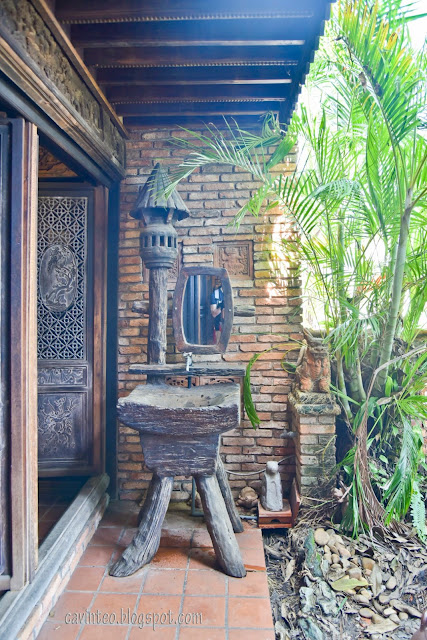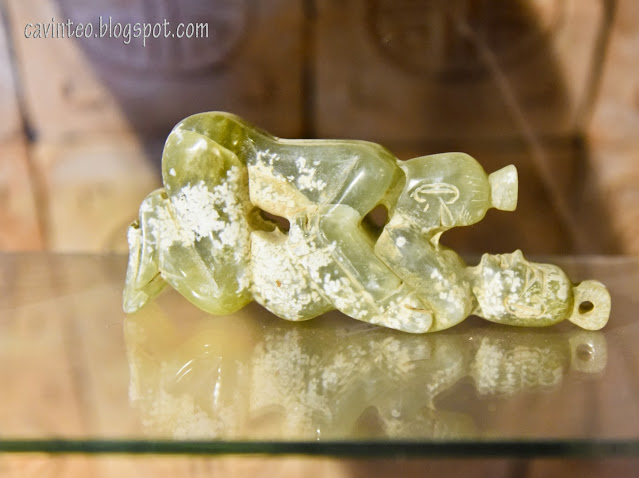Owned and operated by FITO Pharma, the Museum of Traditional Vietnamese Medicine could be an interesting stopover from foreigners, even for those coming from other Southeast Asian countries.
Upon entry, we were each offered a cup of their mix lotus and lingzhi tea; sachets of which we can purchase at a reasonable pricing of just 50,000 dong for one box.
After paying for the entrance fees, the tour started with the three of us seated in a room that reminded me of the tours I had in China, where we were forced to spend out precious time listening to some sales pitch!
Thankfully, it was really just a documentary video on traditional Vietnamese medicine although, it was boring and the blur quality of the video and its concept, could have belonged to the 1980s. Honestly quite torturing to watch.
Museum is six floors high and the route for the self-tour was to take this unconventional wooden lift to the fifth floor, walk up to the sixth floor (not serviced by lift) and check out each level on your descent.
Aside from the lift, you would actually feel that each level was like a traditional wooden house and I must say the museum did a fantastic job in portraying that antiquated look.
Even the interior of the lift made you wonder if such lifts would have existed a few centuries ago. Of course, the noise from the motor and the lighted panel showing the floor would be dead giveaways that it was still modern technology.
A herbal foot bath area, maybe it was reserved for bigger tour groups as we didn't hear anything from the counter staff about this service.
Wooden sink; you wouldn't have thought that this was on level 5, as the landscaping would seem to be on the ground level.
An altar honoring two greatest physicians in Vietnam, Tue Tinh and Hai Tuong Lang Ong Le Huu Trac, who were also known as the authors of books that laid the foundation of traditional Vietnamese medicine.
Some just look like stones to me.
Tree of Vietnamese Traditional Medicine, which listed down 100 famous doctors that had authored books on traditional Vietnamese medicine. Wood carved, this artefact weighed almost 500 kilograms and took two years to complete!
Proceeding up to the sixth floor!
My eyes went wide with the plethora of figurines on the roof, consisting of those with Chinese, Khmer, Indian origins. Truly a sight to behold although they were more for decoration purposes.
Portraits of notable ancient physicians that contributed to Oriental medicine, which included Chinese, Japanese and even Koreans. Some people will always argue about the origins but to me, it's the result that matters.
Could you recognize of them? I remember Hua Tuo, "the first person in China to use anesthesia during surgery" and he lived between year 140 - 208! I used to play games centered on ancient China and his appearance always meant my injured characters will make a full recovery!
Cham Tower - with two facings; the one above was a replica of the "entrance to Thang Long Temple of Medicine built in 1780, at Hanoi". The two characters mean Temple of Medicine.
Phallic artefacts dotted the interior of the tower. Asians are generally conservative and it's quite a surprise to see a section dedicated to sex.
Linga-yoni; said to be the symbol of belief in sex. No idea how parents are going to explain to their kids but it might be a topic starter for the birds and the bees.
View on the 5th floor. That pagoda was from the Vietnamese National Buddhist Temple; also known as Quoc Tu Pagoda. Its history was pretty short, from about 1960s.
Other side of the Cham Tower; influence of Khmer.
Made using red lacquer trimmed with gold, the fifteen pictures showcased scenes of "famous medical physicians and authors from Vietnam traditional medicine dated from the 13th to 18th century".
Proceeding back to the fifth floor.
Some ancient looking medical books and drawings. Most were written in Chinese, signifying the influences of China given their proximity.
Model of Vietnamese Medical House; more a display of a stall that does wholesale medicinal herb business. p.s. this model made good use of a space right above a staircase.
Another red lacquered wood with gold trimmings on a scene for a king's medical institute, otherwise known as the royal health department.
Going to level four.
Ceramic jars and pots with intricate designs; they were used to soak medicinal herbs with alcohol and the best method was to bury them underground for a pre-determined period of time, before usage.
Tools for slicing and grinding herbs!
You can also give it a try! Of course it was fun for the first few minutes but imagine you have to do it throughout the day! I remember watching on television that some would even multitask as the hands are free while the legs are working!
I am more familiar with the mortars as they were more common in households (for mixing chilli), especially when I was living in the kampongs, where the noise from pounding doesn't affect your neighbors.
This, to me, would be a better representation of a typical Vietnamese Medical House. Most medicinal halls would keep the herbs in drawers so as to protect them from water and pests.
"300 samples of medicinal plants and animals and minerals for traditional medicine"!
Everything was labeled with its name written in Chinese, Vietnamese and English. I deeply appreciated the explanation for their properties and benefits for the body. The ones in pink, blue and yellow caught my attention. Do note that not all of them are for consumption.
Hand-drawn, pictorial manuscripts of over 300 medicinal plants. Nowadays, photos would be much more helpful for ease of reference. I think I will die if I ever get lost in the jungle.
Are you aware that lotus is the national flower of Vietnam? Every part of the lotus can be used; flowers for offerings, leaves are used as biodegradable wraps, seeds and roots can be eaten, and some parts can even be used for medicinal purposes.
Pages from a book on acupuncture. There was previously a furor in China over a popular South Korean period drama that seemed to infer that acupuncture originated from South Korea. Nowadays, people very sensitive about such things.
Descending one level down.
Another collection of pots, jars and bottles! I am not exactly clear of their purpose for traditional medicine although I noted some were used to brew medicine.
Temporary storage.
Weighing scales; these were important as the proportion and ratio for herbs cannot be incorrect as a combination is often required to alleviate symptoms or improve conditions, and sometimes taken for long term. Any wrong ratio might result in harm, even death.
Tiny shavers for expensive stuff like ginseng. I imagine this could be used in instances whereby you need a thin slice to be placed in tea. It was said that ginseng improves immunity over time although it also depends on the type of your body; hot or cold. Too hot and ginseng might actually be harmful for your body.
This wine room was enthralling; doubt not many of you would dare to take a sip, especially those that would include animals or their parts.
Like snake wine! How did they even manage to squeeze the snakes in and reposition them?! Some were even holding on to smaller snakes in their mouth. Frankly, I know my parents had a jar of snake wine at home and it had been there since I was young!
Fascinating ginseng wine with the carving of the face of an elderly gentleman! From the size of the ginseng, I am guessing this must be very potent! God knows how much it costs.
Wooden pestle and stone mortar. Both tools were too big for medicine though; such size would be used for food preparation like mochi where constant pounding was necessary to make the glutinous rice paste smooth yet sticky.
Drawings by a Mr Bui Xuan Chuong, who specialized in medicinal plants and his illustrations were often featured in "almost all significant publications on medicinal plants in Vietnam".
Lift door; every level was different if I recall correctly.
My mind went blank when I saw these pots. With just a hole, and no sprout, I had assumed these were ancient urine pots until I noticed a name in English; lime pots.
In some Southeast Asian countries, it's common to chew on betel leaves and this pot was used to hold the powdered lime, "an ingredient mixed with betel nuts and spices". The hole was an opening for guests to insert their finger to extract the lime.
Walking down to the second floor.
Walls of the staircases wouldn't be left empty; plastered the walls between second and third floor would be old advertisements for companies' promotion of medicine! Back then, claims were dubious although such things could still take place in this modern age too.
Portrait of King Thanh Thai - the second floor showcased an imperial setting for the royal health department. No wonder things are nicer and tidier.
Aside from displaying samples of herbs, I also noticed a prescription to make an elixir used for emergencies only. Such is the power of kings, with the ability to get the best treatment, unlike commoners like me.
Kon and us had a discussion about the three Chinese characters 福禄寿; while we are aware of the meanings for 福 and 寿, referring to prosperity and longevity respectively, we weren't aware of what 禄 refers to. A search on the web revealed that it means happiness even though the explanation is quite related to 福!
Products by FITO Pharma! What I missed out from the photo, even though it was partially shown, was another lacquered painting, said to be the pride of this musem! Titled "traditional medicine in the daily life of Vietnamese community", it was said to the "biggest painting about traditional medicine in Vietnam".
Back to the ground floor, where you can buy souvenirs like medicinal products, tea, herbs, and even books on Vietnamese traditional medicine! I got quite a number of boxes for lotus and lingzhi tea!
=====
In a nutshell, I did enjoy myself and it was a walk down memory lane as some of the items were commonly seen when I was younger. Problem was; most things were in Vietnamese and it can be hard to understand what the exhibits were for. Advice - please ask for the laminated booklet which was in English and would provide explanations and information.
41 Hoàng Dư Khương, Phường 12, Quận 10,
Thành phố Hồ Chí Minh, Vietnam
Map
As above.
Website
Adult - 120,000 Dong
Child - 60,000 Dong

































































































%20-%20Pearl%20of%20the%20Far%20East%20@%20Vietnam%20.JPG)
No comments:
Post a Comment